
Solar System
The Earth, just like any other celestial body, is in perpetual motion. Despite our inability to perceive it, the planet is continuously rotating on its axis and orbiting the Sun at an astonishing velocity. We remain oblivious to this motion due to a phenomenon similar to that experienced when traveling in an airplane or car – we are propelled forward at the same speed as the vehicle, thereby creating the illusion of stillness.
What causes the rotation of the Earth on its axis?
The Earth’s rotation on its axis for 24 hours is responsible for the existence of life on our planet. This continuous rotation creates a favorable temperature range by alternating between day and night, allowing for the evolution of life.
It’s important to note that the Earth is not the only planet with this rotational characteristic. Each planet in the solar system has its own distinct rotation. For instance, Mercury, the closest planet to the Sun, completes one rotation in 59 Earth days, while Venus takes 243 days and rotates in the opposite direction.
It is common knowledge that the Earth rotates, and this may seem like basic information, but upon closer examination, the reason behind this phenomenon is not entirely obvious. In order to shed light on this matter, we must delve into the formation of the entire solar system.
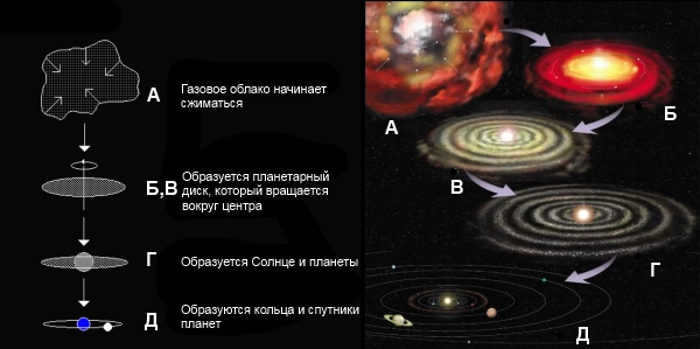
At first, the solar system existed as a massive cloud of dust and gas, which gradually collapsed and transformed into a massive disk. This disk continued to accelerate its rotation, akin to a figure skater extending her arms to increase her speed. The sun formed at the center, while the planets began to assemble in the periphery. All the components that constitute our system exist on the same plane and move in the same direction, as they all originated from the same cosmic dust disk.
During the process of planetary and celestial body formation, the solar system experienced a constant state of agitation due to frequent collisions between debris, resulting in their rotation. On occasion, the gravitational pull of larger debris attracted smaller ones, giving rise to satellites.
What causes the Earth to rotate faster on its axis compared to other planets?
According to scientists, the Earth’s faster rotation can be attributed to a significant event in its history. It is believed that a massive object, roughly the size of Mars, collided with our planet, resulting in a chunk being separated and forming the Moon. This collision had the effect of increasing the Earth’s rotation speed, setting it apart from other planets in our solar system.
It is worth noting that the Moon’s gravitational pull has an influence on the Earth’s rotation, causing it to gradually slow down over time.
A fascinating fact: During the early stages of the Earth’s formation, the length of a day was estimated to be only 6 hours. Thanks to advanced technologies, scientists can now predict the ongoing deceleration of the Earth’s rotation. In a hundred years, it is anticipated that the day will be 2 milliseconds shorter.
What is the rotational speed of the Earth?
Speed can be measured in relation to a specific reference point. When determining the rotational speed of the Earth, we consider the rotation relative to its center.
The Earth completes one revolution in a period of 23 hours, 56 minutes, and 4.09053 seconds, known as the sidereal period. The circumference of the Earth is approximately 40,075 kilometers. To calculate the rotational speed, divide the circumference by the time, resulting in approximately 1674 km/h or 465 m/s.
Correlation between Earth’s Rotation Speed and Latitude
However, it’s crucial to consider that the Earth’s circumference varies based on its latitude, as the planet becomes narrower towards the poles. Consequently, the speed of rotation differs across different latitudes. The smaller the radius, the slower the speed. Thus, at the North and South Poles, the rotation speed is nearly zero.
If you’re interested in determining the rotation speed achievable at various latitudes, it only requires multiplying the cosine of the particular latitude (which can be calculated using a calculator or referenced from a cosine table) by the equatorial rotation speed (1674 km/h). For instance, the cosine of 45 degrees is 0.7071, resulting in a speed of 1183.7 km/h at this latitude: 1674 x 0.7071 = 1183.7 km/h.

The velocity of Earth’s rotation at various latitudes
- 10°: 0.9848×1674=1648.6 km/h;
- 20°: 0.9397×1674=1573.1 km/h;
- 30°: 0.866×1674=1449.7 km/h;
- 40°: 0.766×1674=1282.3 km/h;
- 50°: 0.6428×1674=1076.0 km/h;
- 60°: 0.5×1674=837.0 km/h;
- 70°: 0.342×1674=572.5 km/h;
- 80°: 0.1736×1674=290.6 km/h.
Fascinating fact: Space agencies take advantage of Earth’s rotational velocity on its axis. Since the highest rotational velocity is near the equator, less resources are needed to launch spacecraft from zero latitude.
Cyclical deceleration
There has been an observation made by scientists that suggests a connection between seismic activity per annum and the Earth’s rotational speed. While it is believed that there is no direct correlation between these two phenomena, it is crucial for experts to discover any potential hints. These clues would not only enhance our understanding of our planet but could also potentially save countless lives.
Just as everything in nature follows a cyclical pattern, the rotation of our home planet is also cyclical. The Earth experiences five-year cycles of deceleration and acceleration.
Oscillation of the Earth’s axis
When it comes to the oscillation of the Earth’s axis, there are two terms used in physics – precession and nutation.
Precession refers to the phenomenon where the momentum of a celestial body changes its direction in space. To understand this concept, let’s consider the example of a spinning top. Initially, the top has a vertical axis of rotation. However, due to gradual deceleration, the top starts to lose speed, leading to a gradual deviation of its axis from the vertical. As a result, the top begins to trace out a cone-like shape. This motion is known as precession.
On our planet, the situation is more grave and slower. This particularity in the motion of our home planet was observed even by the ancient geographer and astronomer Hipparchus, who referred to this phenomenon as the precession of the equinox. The period of Earth’s precession is incredibly long – 25 thousand years. Scientists attribute periodic climate changes to this movement of the planet. Eventually, the fluctuations will become so pronounced that it will be impossible to navigate using the old celestial maps due to the displacement of all the stars relative to the equatorial line.
Nutation is a relatively subtle movement that resembles a sort of rocking or nodding motion characteristic of a solid body undergoing precession. It is a slight wobble of the Earth’s axis superimposed on the precessional motion.
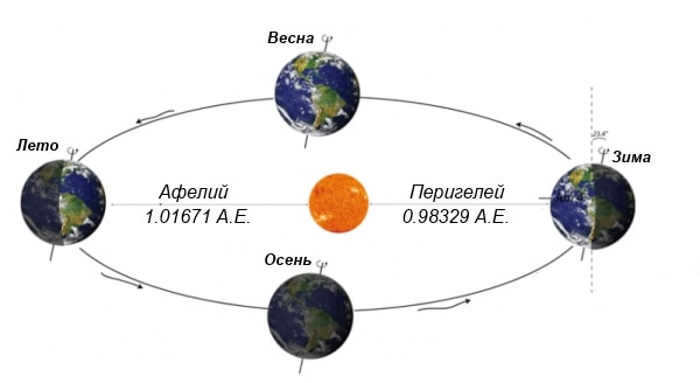
We must not forget that the Earth’s movement includes not only its own rotation but also its orbit around the Sun. Our home is approximately 149,600,000 kilometers away from the star.
Our planet completes its entire orbit around the star in 365.256 days at a velocity of 108,000 km/h or 30 km/s.
Fascinating fact: It was not until the 16th century that people acknowledged that the Earth revolves around the Sun, and not the other way around! Some scientists even paid the price with their lives for such “heresy”.
Various movements
The solar system is not a static entity devoid of movement. In actuality, while all the rotations within the system are taking place, it is also hurtling through space at an astonishing velocity.
Positioned on one of the outer arms closer to the periphery, our system is approximately 26,000 light-years away from the central hub of the Milky Way galaxy, which spans a width of 80,000 to 120,000 light-years and has a thickness of 7,000 light-years. Remarkably, it requires a span of 200 to 250 million years for our system to complete a full revolution around the galaxy’s core. During this trajectory, the solar system is propelling itself at a staggering 250 kilometers per second.
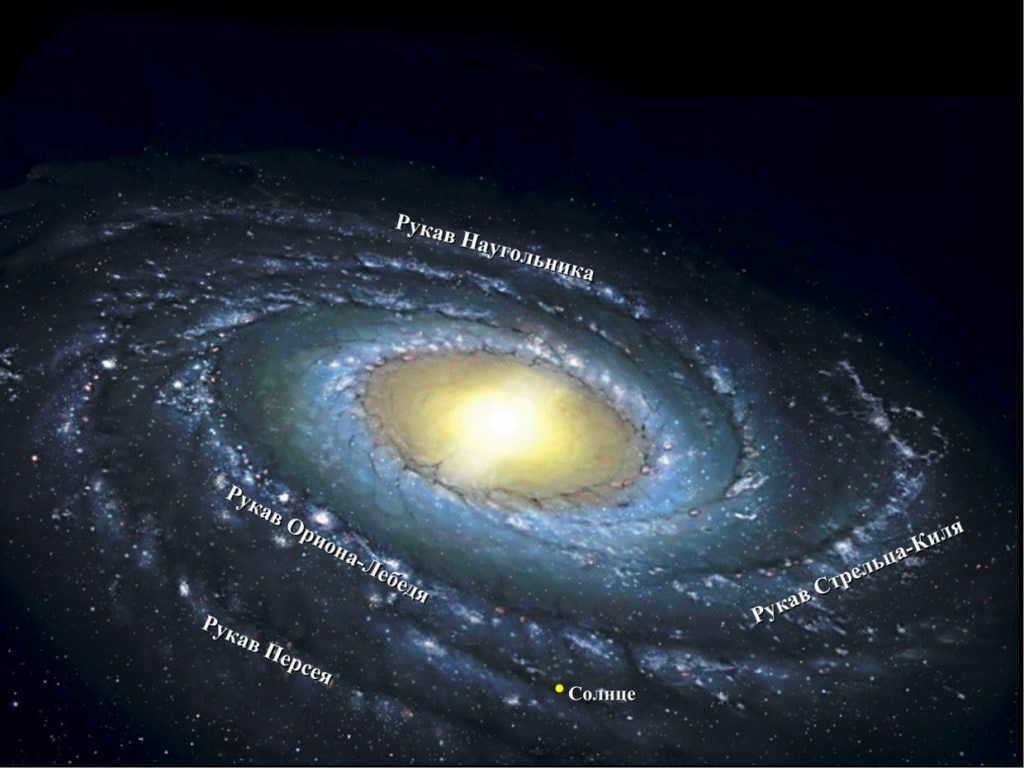
The Milky Way is part of a larger system called the Local Group, which is a gravitationally bound group of galaxies. Within this system, the Milky Way is moving at a speed of approximately 300 kilometers per second.
What would happen if the Earth suddenly stopped rotating?
The chances of being suddenly flung into space are nonexistent thanks to gravity, which continuously pulls us towards the Earth. However, it’s important to note that gravity is not uniform across the entire planet. Our planet’s shape is spherical, but due to its rotation, it is slightly flattened at the poles. The fastest speed is found along the widest circle, which is the equator. Interestingly, gravity is 0.3% stronger at the equator!
The gradual deceleration option, however, presents a genuine scenario that our planet will encounter in the distant future. The minimum velocity at which the Earth can decelerate is one rotation per 365 days. This phenomenon is referred to as “sun synchrony”. In this scenario, one side will perpetually face the Sun, while the other side, akin to the Moon, will remain in constant darkness. Nevertheless, as per statements from NASA, one can adapt to such a situation.
Let’s discuss the full stop once again: in the event that the Earth comes to a halt, it is highly likely that the magnetic field, which is primarily generated by the planet’s rotation, would be lost. Consequently, we would no longer have the Van Allen radiation belts and the auroras, rendering us completely vulnerable to cosmic radiation. Under such circumstances, with each solar radiation outburst, the Earth would be bombarded with such a massive dose of radiation that there would be very few organisms left alive.
However, there is no need to be concerned! The chances of such scenarios occurring are virtually nonexistent!
If you happen to spot an error, kindly highlight the text fragment and press Ctrl+Enter.
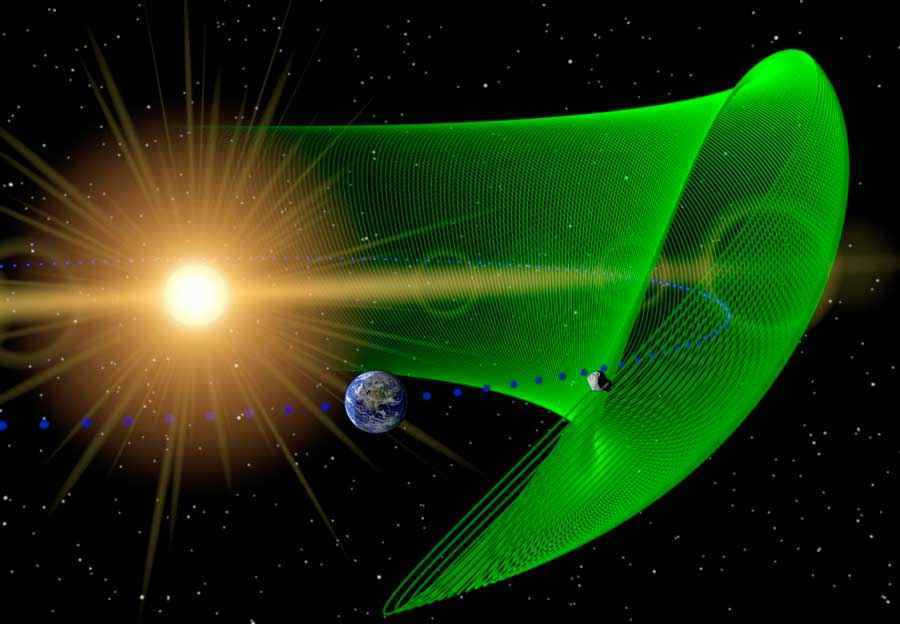
As we learned in our educational curriculum, the Earth undergoes rotation with respect to the Sun. The Earth’s orbit represents the path that our planet follows as it revolves around the star. Are there any distinctive characteristics associated with this trajectory?
The form of the path
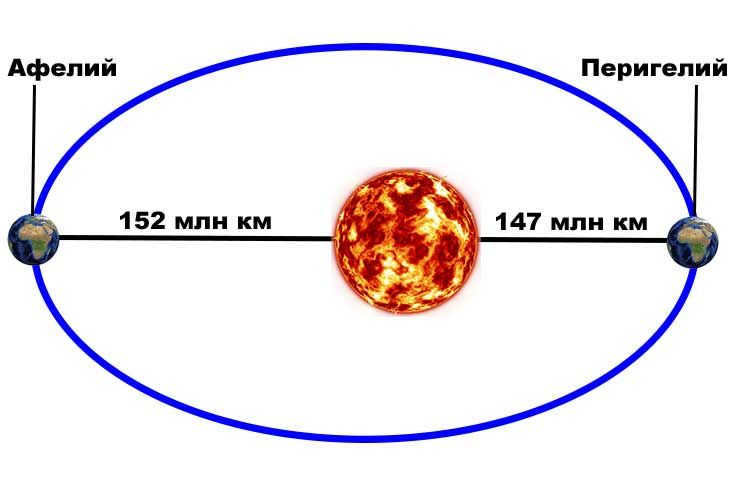
For a considerable period of time, astronomers had the belief that the paths followed by celestial bodies were circular. Nevertheless, Johannes Kepler discovered that the planets, including our very own Earth, actually travel along an elliptical path, with the Sun occupying one of the foci of this ellipse.
An ellipse, which bears a resemblance to a flattened circle, possesses a parameter referred to as eccentricity. This parameter determines the extent to which the shape of the ellipse deviates from that of a circle. The value of eccentricity can range from zero to one. In the event that the value equals zero, the orbit assumes the form of a perfect circle, with the star being situated at its center. Earth has an eccentricity of 0.0167, signifying that our orbit is extremely close to being circular.
The slight variation in the Earth’s orbit radius is crucial for supporting life on our planet, as it helps maintain a stable average temperature. To put it into perspective, the orbit radius of Mercury fluctuates between 46 and 70 million kilometers, which results in an eccentricity value of 0.2.
Distance between Earth and Sun
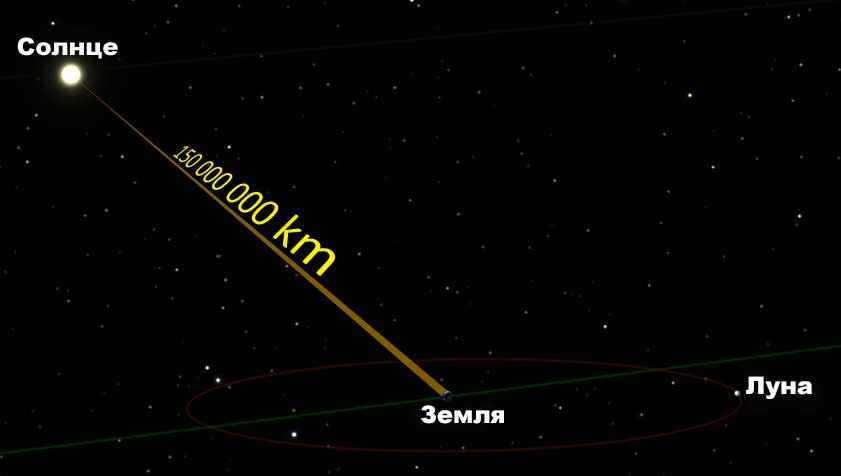
One astronomical unit is defined as the average radius of the Earth’s orbit, which is approximately 150 million km. This unit of measurement is commonly used to describe distances in outer space, especially when referring to the solar system.
In 1961, Soviet astronomers utilized radiolocation of Venus to acquire a more precise measurement of the astronomical unit. Their findings yielded a value of 149,599,300±2000 km.
Earth’s velocity
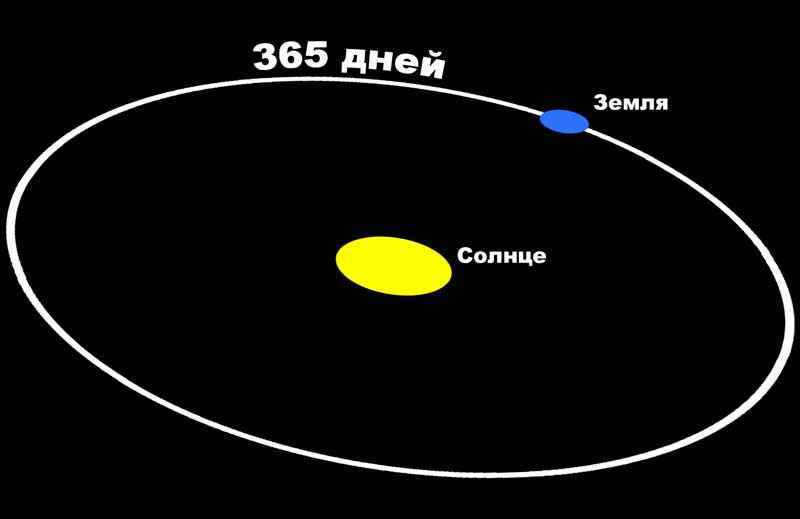
The Earth completes its orbit around the sun, covering a total distance of 940 million km, within a span of 365.25 days. This is why every fourth year, known as a leap year, an extra day is added to the month of February. It is interesting to note that celestial bodies traverse their orbits at varying speeds. The planets move at their fastest when they are closest to the sun, in a region called the pericenter. On the other hand, they slow down considerably when they are farthest from the sun, in a region known as the apocenter. The Earth reaches its aphelion, or farthest point from the sun, on July 3, during which it slows down to a speed of 29.2 km/s. Conversely, on January 3, our planet reaches its perihelion, or closest point to the sun, and accelerates to a speed of 30.2 km/s.
The path of the orbit
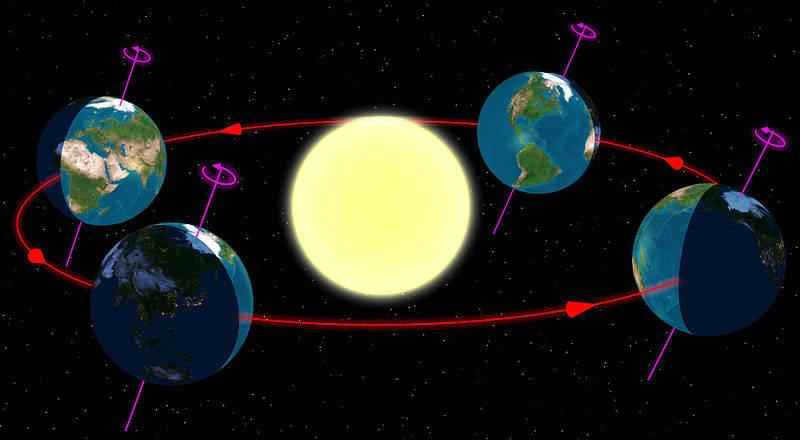
Every celestial body follows a specific path, known as an orbit, which is a two-dimensional figure where all its points lie in the same plane. The Earth’s orbit, for example, is called the ecliptic. Interestingly, almost all the planets in our solar system have orbits that are close to the ecliptic. However, the Earth’s axis of rotation is tilted at an angle of 23° to the ecliptic. This tilt is responsible for the uneven heating of the Northern and Southern Hemispheres during different parts of the Earth’s orbit, leading to the seasons. When it is summer above the equator, it is winter below it, and vice versa.
The shape of the orbit deviates from its ideal state
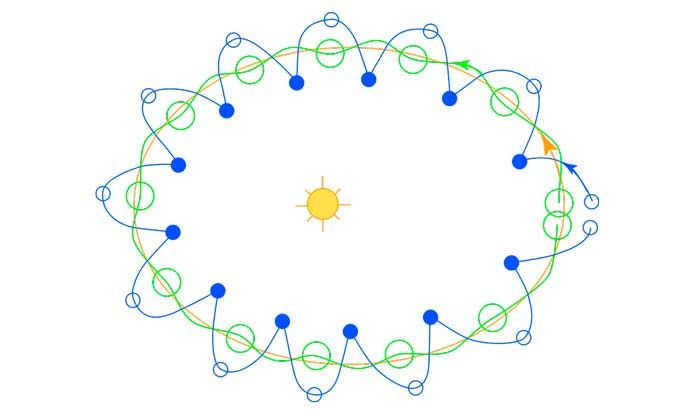
Kepler’s concept that the paths of celestial objects are elliptical perfectly explained the behavior of the planets according to XVII century observers. However, as measurements became more precise, deviations from Kepler’s laws began to be discovered. The reason for this is that the mathematical model suggested by the German astronomer was based on two simplifications:
- The planet’s mass is considered negligible compared to the star’s mass;
- Only the gravitational interaction between the star and the planet is taken into account, disregarding the influence of other bodies (such as other planets).
Undoubtedly, the reality of the situation is much more intricate. In actuality, it is more precise to acknowledge that it is not solely the Earth that orbits around the Sun, but rather both celestial bodies rotate in relation to a shared center of mass, which is referred to as the barycenter. However, due to the substantial mass of the star, the barycenter lies within it.
Precise astronomical measurements indicate that presently, the distance between the Earth and the Sun is gradually expanding at a rate of 15 centimeters per annum. Nonetheless, this does not imply that our planet will continuously drift away from the celestial body; periods of separation can alternate with periods of convergence.
As an illustration, the astronomer Milutin Milankovic made a groundbreaking observation that the Earth’s orbit does not have a constant eccentricity, but rather undergoes cyclic changes. These cycles have a duration of approximately 100 thousand years, during which the eccentricity fluctuates between 0.005 and 0.05. It is precisely these variations that are responsible for the occurrence of ice ages.
Based on Kepler’s laws, it is theoretically possible for the planets to orbit the star indefinitely. However, deviations from these laws can lead to potential instability, resulting in the planets either leaving their orbits or crashing into the star. Analytically calculating this is impossible, necessitating the use of computer modeling.
Due to the complexities involved, it is not possible to accurately predict the fate of the planets in the solar system. In certain models, Mercury is projected to either collide with the Sun or collide with Venus or Earth. Such events could also trigger collisions between other planets. However, these catastrophic events would likely occur over billions of years.


The Earth is in a perpetual state of motion. While it may appear that we are stationary on the planet’s surface, the Earth is constantly rotating on its axis and orbiting the Sun. This movement is imperceptible to us, similar to the sensation of flying in an airplane. Just as we travel at the same speed as the aircraft, we do not experience any sense of motion.
What is the speed of Earth’s rotation on its axis?
The Earth completes one full rotation on its axis in approximately 24 hours (to be precise, in 23 hours 56 minutes 4.09 seconds or 23.93 hours).. With the equator having a circumference of 40075 km, any object located on the equator is moving at a velocity of about 1674 km per hour or roughly 465 meters (0.465 km) per second (dividing 40075 kilometers by 23.93 hours gives us 1674 kilometers per hour).
However, at the North Pole (90 degrees north latitude) and the South Pole (90 degrees south latitude), the linear speed is virtually zero as the points on the surface of the poles rotate at an extremely slow pace.
The cosine of the desired latitude can be easily determined using a calculator or by referring to the cosine table.
The linear velocity of the Earth’s rotation for different latitudes:
- For a latitude of 10 degrees: 0.9848 × 1674 = 1648.6 kilometers per hour;
- For a latitude of 20 degrees: 0.9397 × 1674 = 1573.1 kilometers per hour;
- For a latitude of 30 degrees: 0.866 × 1674 = 1449.7 kilometers per hour;
- For a latitude of 40 degrees: 0.766 × 1674 = 1282.3 kilometers per hour;
- For a latitude of 50 degrees: 0.6428 × 1674 = 1076.0 kilometers per hour;
- For a latitude of 60 degrees: 0.5 × 1674 = 837.0 kilometers per hour;
- For a latitude of 70 degrees: 0.342 × 1674 = 572.5 kilometers per hour;
- For a latitude of 80 degrees: 0.1736 × 1674 = 290.6 kilometers per hour.
Cyclic Braking
Everything is cyclical, including the speed of our planet’s rotation, which can be measured by geophysicists with millisecond precision. The Earth’s rotation typically experiences deceleration and acceleration cycles that last for five years, and it is often observed that the last year of the deceleration cycle coincides with a significant rise in global earthquake activity.
As 2018 marks the end of the deceleration cycle, scientists anticipate an increase in seismic activity during this year. While correlation does not necessarily imply causation, geologists are constantly searching for tools that can help them predict the timing of the next major earthquake.
Changes in the Earth’s Axis
The Earth experiences small oscillations while it spins, resulting in a drifting axis at the poles. Since the year 2000, there has been an observed acceleration in the drift of the Earth’s axis, moving at a speed of 17 centimeters per year towards the east. Scientists have determined that this eastward movement is due to a combination of factors, including the melting of Greenland and Antarctica, as well as the loss of water in Eurasia.
It is believed that changes occurring at 45 degrees north and south latitude have a significant impact on axis drift. This recent discovery has provided scientists with an explanation for the long-standing question of why the axis drifts. The axis can swing either eastward or westward as a result of dry or wet years in Eurasia.
What is the velocity at which the Earth orbits the Sun?
Aside from the rotational speed of the Earth, our planet also travels around the Sun at a velocity of approximately 108,000 kilometers per hour (or around 30 kilometers per second), and completes one full orbit around the Sun in 365,256 days.
Only in the 16th century did individuals come to understand that the Sun is the focal point of our solar system and that the Earth revolves around it rather than being the stationary center of the universe.
The Earth is in constant motion, never standing still. It revolves around the Sun, resulting in the changing seasons on our planet. However, it is often overlooked that while circling the celestial luminary, the Earth also simultaneously rotates around its own axis. This rotation is what brings about the transition from day to night, known as diurnal movement.
To gain a better understanding of the Earth’s rotation around the Sun and its axis, we turn to Alexander Perkhnyak, an astrophysicist and staff member at the Moscow Planetarium, who shared insights with AiF.ru.
The Earth’s Rotation Around its Axis
What is the mechanism of Earth’s rotation?
When Earth rotates around its axis, there are two fixed points: the North and South Poles. By connecting these points with an imaginary line, we can define the axis around which Earth rotates. It is important to note that Earth’s axis is not perpendicular, but inclined at an angle of 23.5° to its orbit around the Sun.
What is the speed of the Earth’s rotation around its axis?
The Earth’s rotation speed around its axis is approximately 465 m/s or 1,674 km/h. The speed of rotation decreases as you move farther away from the equator.
“Not many people are aware that the speed of the Earth’s rotation slows down as you move away from the equator. This can be visualized with the following example. The city of Quito, located near the equator, rotates with the Earth at a speed of 465 m/s, which is unnoticeable to its residents. However, people living in Moscow, much further north of the equator, experience a rotation speed that is almost half of that, around 260 m/s,” said Perkhnyak.

What is the direction of the Earth’s rotation?
The Earth rotates on its axis from west to east. When viewed from above, looking towards the North Pole, it rotates counterclockwise.
Does the speed of the Earth’s rotation change?
Indeed, it does. Every year, the Earth’s rotation slows down by an average of 4 milliseconds.
“Astrophysicists attribute this phenomenon to the gravitational pull of the Moon, which is known to have an effect on the tides on our planet. Therefore, when these tides occur, the Moon appears to be attempting to draw water towards itself, causing it to move in the opposite direction of the Earth’s course. As a result of this unique counteraction, a slight friction force is generated at the bottom of bodies of water, which, in accordance with the laws of physics, slows down the Earth’s rotation speed. Although this effect is minimal, it accounts for a decrease of only 4 milliseconds per year,” Perkhnyak specified.
The revolution of the Earth around the Sun
What is the Earth’s orbit around the Sun like?
The Earth completes a journey of over 930 million kilometers as it orbits around the Sun.
How fast does the Earth move in its orbit?
The Earth moves at a velocity of 30 km/s, equivalent to 107,218 km/h, as it revolves around the Sun.
How long does it take for the Earth to make a full revolution around the Sun?
It takes approximately 365 days for the Earth to complete one full revolution around the Sun. This time period is known as a year.

What is the direction of the Earth’s movement while orbiting the Sun?
The Earth orbits the Sun in a west to east direction, just like it rotates around its own axis.
What is the approximate distance of the Earth’s orbit around the Sun?
The Earth’s orbit around the Sun has a distance of approximately 150 million kilometers.
What causes the changing of seasons?
The changing of seasons is caused by the Earth’s rotation around the Sun and its angle of inclination. Throughout its orbit, the Earth remains at a consistent angle, resulting in different parts of the planet being more or less exposed to the Sun’s rays. This variation in exposure leads to the different seasons experienced in different hemispheres.
During one part of its orbit, the Earth’s lower half, known as the Southern Hemisphere, is more turned toward the Sun. This results in warmer temperatures and longer days, leading to the season of summer. Conversely, during this time, the North Pole is almost hidden from the Sun, leading to colder temperatures and shorter days, which are characteristic of winter.
Twice a year, the Sun illuminates the Northern and Southern Hemispheres in a similar way, resulting in equal day and night lengths. These moments are known as the spring and fall equinoxes, and mark the transition between the seasons of spring and fall. During these times, the temperatures and daylight hours are more moderate and balanced between the two hemispheres.
What is the reason for the Earth’s ability to avoid falling into the Sun?

“When the Sun exerts its gravitational pull on the Earth as it orbits around it, a centrifugal force is generated. This force constantly tries to push our planet away from the Sun. However, due to the Earth’s consistent speed and its optimal distance from the Sun, which is aligned with the centrifugal force, the Earth remains in its orbit. This is why the Earth does not fall into the Sun or escape into space, but instead continues to follow its designated path,” explained Alexander Perkhnyak.
*The Earth’s axis is an imaginary vertical line that runs from the North Pole to the South Pole, passing through the center of the Earth. The Earth rotates around this axis.
**Earth’s orbit refers to the path that the Earth follows as it revolves around the Sun.
***The Equator is an imaginary line that divides the Earth into the Northern Hemisphere and the Southern Hemisphere.
What is the speed at which the Earth spins on its axis? It is common knowledge that the transition from day to night is a result of the Earth’s rotation. However, have you ever pondered upon the exact speed at which it rotates? And how can this speed be calculated?
When discussing uniform motion on a circular path, we can identify two velocities: angular (ω) and linear (v). Let’s determine both for our magnificent planet.
The Earth’s rotation and its angular velocity
The angular velocity of an object refers to how quickly its angle changes over time. In the case of the Earth’s rotation, one complete revolution corresponds to an angle of 360 degrees or 2π radians, and this rotation occurs within a specific time period known as T. Therefore, the angular velocity can be expressed as:
It is worth mentioning that the value of 2π in this equation represents the full circle or one complete revolution.
Another way to understand the concept of radians is by considering that one radian represents an angle with an arc length equal to the radius of the circle. Therefore, to calculate the number of radians in a circle, we need to divide the circle’s circumference (2πR) by its radius (R). After simplifying the equation, we obtain the value of 2π or approximately 6.28.
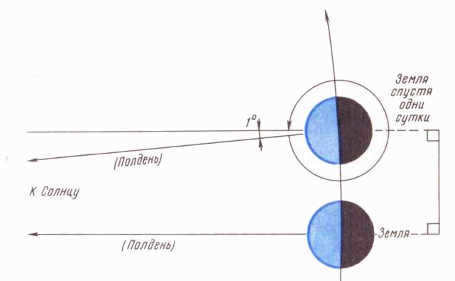
The angular velocity can now be determined:
![]()
The Earth’s rotational speed
When discussing the angular velocity, it remains constant for any location on our planet. Whether it be a penguin in Antarctica, an elephant in Africa, or even yourself at home, everyone experiences the same angular velocity. However, the linear velocity tells a different story. It reaches its maximum at the equator and gradually decreases towards the poles due to its direct correlation with the radius of the rotation circle. This means that if you were to climb onto a stool to change a light bulb, your linear velocity would increase. Technically speaking, linear velocity describes the rotation of specific points on the Earth rather than the overall rotation around its axis.
Calculating linear velocity is an easy task. Velocity is defined as the ratio of the distance traveled to the time it took to travel that distance. If we travel a distance equal to the circumference of a circle in one revolution, and the time it takes to complete one revolution is the period T, then we can calculate the linear velocity using the formula L = 2πR, where R is the radius of the circle. So, the equation to calculate the linear velocity is:
Since the angular velocity is , we can write:
The equatorial radius of the earth is R = 6378245 m, which means that the linear velocity at the equator will be: m/s.
For reference, the speed of sound in air is 365 m/s. This implies that, while sitting calmly in a chair somewhere in Africa or Indonesia, we will be traveling at speeds exceeding the speed of sound. If you convert that to kilometers per hour, it is 1674 kilometers per hour. In general, these speeds are comparable to those of supersonic aviation.






